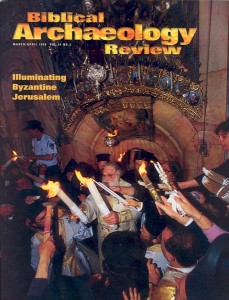Jerusalem as Mosaic
Sidebar to: Illuminating Byzantine Jerusalem

Jerusalem, for Byzantine Christians, was the center of the earth and the focal point of spiritual experience. Pilgrims flocked to the sites where the New Testament says Jesus lived, died and was resurrected, and emperors built monumental churches—dedicated to Jesus, Mary and the apostles—throughout the city. These churches dominate the city in the oldest existing map of Palestine—the Madaba map.30 Made of more than 700,000 ceramic tiles, or tesserae, this mosaic map covers part of the floor of a church in Madaba, Jordan, a city about 20 miles south of Amman. The mosaic was created in the mid- to late sixth century, probably during the reign of Emperor Justinian (527–565), who commissioned some of the most impressive churches depicted on the map.
The map was discovered in the early 1880s, when a group of displaced Greek Orthodox Christians received permission from the Turkish government in Istanbul to settle in Madaba. The government permitted the settlers to build churches—but only where churches had existed in antiquity. The Christian immigrants found plenty of sites, for Madaba had flourished as a bishop’s see during the Byzantine period (fourth to seventh centuries). In 1884, as the settlers removed debris and rubble from the foundation walls of an ancient cathedral, they discovered the mosaic map. They repaired the floor roughly and incorporated it into a new small church, dedicated to St. George.
Already a library member? Log in here.
Institution user? Log in with your IP address.

